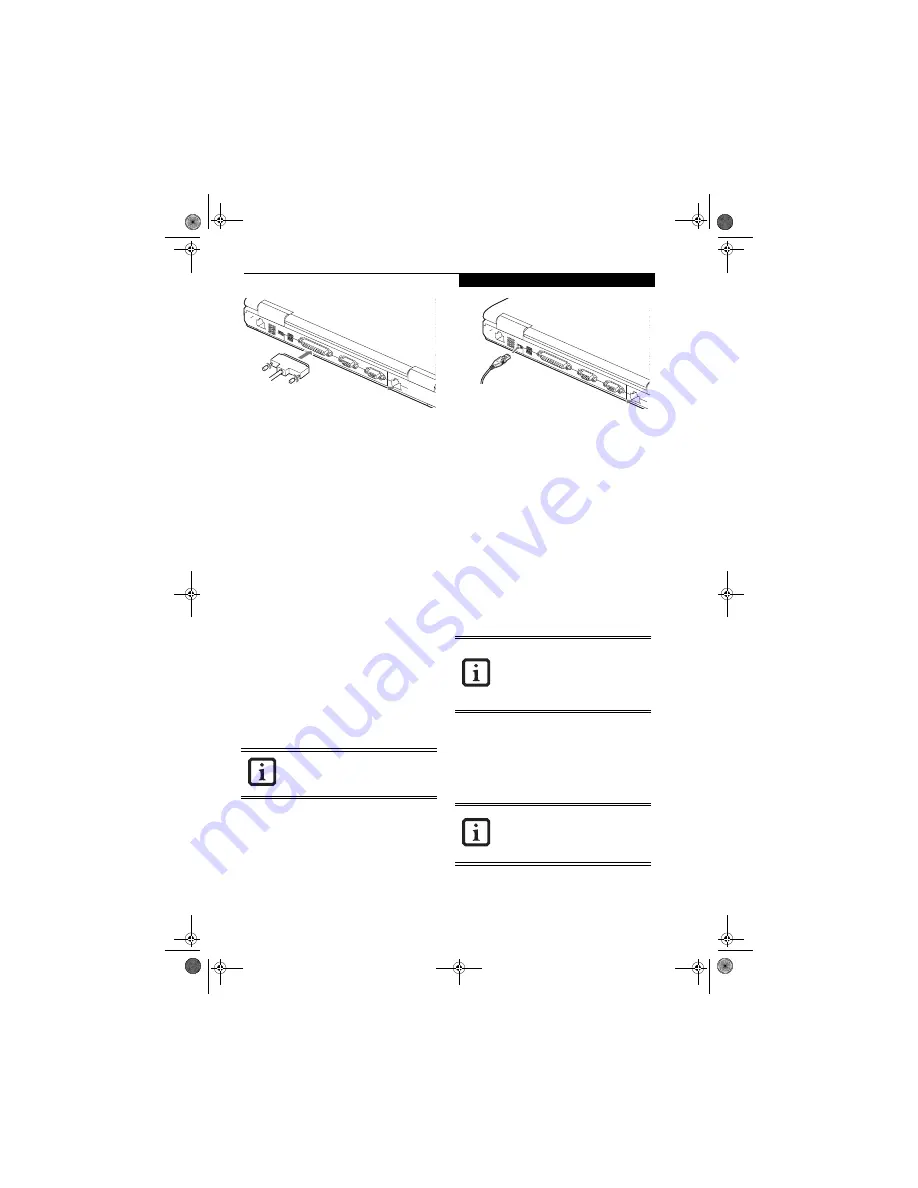
45
U s e r I n s t a l l a b l e F e a t u r e s
Figure 4-14. Connecting a Parallel Device
SERIAL PORT
The serial port, or COM port, located on the system and
on the optional Port Replicator allows you to connect
serial devices, such as printers or scanners. In order to
connect a serial interface device follow these easy steps:
1. Align the connector with the port opening.
2. Push the connector into the port until it is seated.
3. Tighten the two hold-down screws, located on each
end of the connector.
DOCKING PORT
The docking port is used for the connection of your
notebook to an optional port replicator or docking
station. In order to connect your notebook to one of
these devices follow the instructions that came with your
docking port.
(See figure 2-7 on page 10 for location)
UNIVERSAL SERIAL BUS PORTS
There are four USB 2.0 ports on this system (three on
the back and one on the side). The Universal Serial Bus
2.0 ports (USB) allow you to connect USB devices such
as external game pads, pointing devices, keyboards and/
or speakers.
In order to connect a USB device follow these steps:
1. Align the connector with the port opening.
(Figure 4-
15)
2. Push the connector into the port until it is seated.
Figure 4-15. Connecting a USB Device
INFRARED PORT
The infrared IrDA (4Mbps) port allows for wireless data
transfer between your notebook and other IrDA-
compatible devices, such as another computer or a
printer, without the use of a cable.
(See figure 2-4 on
page 7 for location)
It is important to keep in mind that while carrying out
IR communication, both devices must be placed so their
infrared ports are directly facing each other without
obstruction. The devices must be separated by at least 6"
but no more than 36" for maximum performance.
The following conditions may interfere with infrared
communications:
■
A television, radio remote control unit, or a wireless
headphone is being used nearby.
■
Direct sunlight, fluorescent light, or incandescent light
shines directly on the port.
IEEE 1394 PORT
The 4-pin 1394 port allows you to connect digital
devices that are compliant with IEEE 1394 standard. The
IEEE 1394 standard is easy to use, connect, and discon-
nect. This port can allow up to 400 Mbps transfer rate. A
third-party application may be required to operate your
digital device with the 1394 port
.
In order to connect a 1394 device, follow these steps:
1. Align the connector with the port opening.
Due to the ongoing changes in USB tech-
nology and standards, not all USB devices
and/or drivers are guaranteed to work.
■
Do not move either device while com-
munication is active as it may interrupt
data transmission.
■
Be careful not to scratch the infrared
port lens. Dirt, scratches, or other sur-
face marks can degrade operation.
The 1394 port used in this system uses a
four-pin configuration. If you intend to
interface with devices which use a six-pin
configuration, you will need to purchase
an adapter.
cotton.book Page 45 Wednesday, August 17, 2005 1:20 PM
Summary of Contents for Lifebook C1320D
Page 7: ...1 Preface cotton book Page 1 Wednesday August 17 2005 1 20 PM ...
Page 31: ...23 3 Getting Started cotton book Page 23 Wednesday August 17 2005 1 20 PM ...
Page 39: ...31 4 User Installable Features cotton book Page 31 Wednesday August 17 2005 1 20 PM ...
Page 55: ...47 5 Troubleshooting cotton book Page 47 Wednesday August 17 2005 1 20 PM ...
Page 71: ...63 6 Care and Maintenance cotton book Page 63 Wednesday August 17 2005 1 20 PM ...
Page 77: ...69 7 Specifications cotton book Page 69 Wednesday August 17 2005 1 20 PM ...
Page 83: ...75 8 Glossary cotton book Page 75 Wednesday August 17 2005 1 20 PM ...
















































